
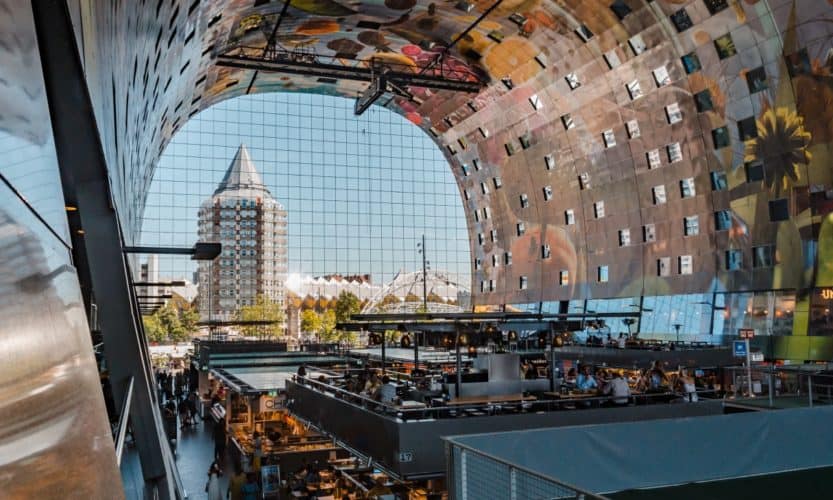
Discover everything the Rotterdam food scene has to offer, from cheap coffee shops to trendy vegetarian restaurants. These are our favourite places to eat in Rotterdam.
Nicknamed ‘Gateway to the World’ thanks to its extensive public transport system, Rotterdam has internationally-inspired eateries sprawled all across town. With plenty of new Rotterdam restaurants and bars opening their doors every day, there has never been a better time to eat out.
In this article, you’ll find well-established institutions and new kids on the block alike. This is the ultimate foodie guide to Rotterdam.
If you’re wondering about my favourite places to eat and drink in Rotterdam, check out the embedded map below (or click the link if the map isn’t showing)
Why don’t you start your journey to Rotterdam by watching my travel video?
Skip ahead with the following links:
Bertmans is a breakfast restaurant in Rotterdam where you can go for a reliable meal at the start of your adventure-filled day.
Bertmans serves both sweet and savoury dishes, with plenty of vegetarian, vegan and gluten-free options for you to choose from.
My personal recommendation: French toast with an iced latte.
Baker & Moore was founded by Paul & Eline, who had always dreamed about starting something and decided to pursue their dream after a round-the-world trip.
At Baker & Moore, you’re in charge. You can assemble a sandwich, salad or yoghurt bowl the way you want to, using their #CreateItYourself formula.
You can come here for all-day breakfast, lunch, or just a drink.
What’s in a name, right? At Bagels & Beans, you can find great bagels, salads, coffee and other drinks at reasonable prices.
Don’t let the fact that this is a chain scare you away. After all, there must be a reason for the company’s success, right?
In the case of B&B, the success is in its simplicity and its accessibility: you can practically find a franchise around every corner in major Dutch cities.
Harvest Coffee Brewers is a place where good food, good coffee and good service come together.
Both founders worked in the Melbourne hospitality industry, where your ability to prepare a great cup of coffee can make or break your reputation. In other words, they know what they’re doing.
At Harvest, they share their Melbourne experiences with the people of Rotterdam, so you may as well enjoy it.
One of my favourite places to get coffee in Rotterdam was Coffeecompany.
If you’re looking for a Starbucks-like coffee chain that’s not Starbucks, Coffeecompany is the place to go for you.
Visiting this place was a part of our morning routine of getting coffee, orange juice and pastries and eating them in our hotel room, and I would highly recommend it.
People with eagle eyes will notice that this is the second time I’m mentioning Baker & Moore.
But I’m the one writing this Rotterdam food guide, so if you have a problem with that, you’re going to have to find a way to deal with it. 🤷
I’m just mentioning them again because they also turn out to have splendid coffee, iced tea and other brunchy drinks.
In its essence, Lilith is a rebellious vegetarian breakfast & coffee place in Rotterdam with a large array of plant-based and gluten-free options.
If you’re looking for great coffee, friendly service and kick-ass American pancakes in an Instagram-friendly interior, you’re not going to find a better spot than Lilith.
Lilith was recommended to me by a friend who’s actually from Rotterdam! If even the locals approve, you’re doing a good job as a restaurant.
Mecca is originally a restaurant that serves some of the best Arabic, Lebanese and Mediterranean food in Rotterdam, consistently recommended by many magazines and bloggers.
But a little-known fact is that the coffee at Mecca is also splendid.
So if you’re in the neighbourhood and you want to unwind, drink some coffee and enjoy the serenity of the surroundings, be sure to pop inside or take a seat on the gorgeous outside terrace.
Markthal isn’t technically a restaurant, but you’ll understand why I put it on this list once you go there.
The best way to describe Markthal I can think of is this: it’s an indoor food court inside a huge dome.
Popular stalls and shops inside Markthal feature authentic food and drinks from all kinds of culture and will give you Dutch stroopwafels, Japanese ramen noodles and Spanish tapas, among many other delicious meals.
Destino is a contemporary Spanish tapas restaurant with a menu that changes every 8 weeks.
If you’re looking for the best classic Spanish dishes with a twist or surprising new Spanish-inspired combinations, look no further than this trendy restaurant, which is located in the up-and-coming neighbourhood Oude Noorden (Old North).
Added bonus: you can find Spanish recipes and an extensive list of tips for restaurants in Spain on Destino’s website.
Op Het Dak is more than a restaurant — it’s an experience.
At a ten minute walk from the central station, you’ll find the first rooftop farm and urban garden of Holland. Attached to this is a place where you can have breakfast and lunch, with a focus on clean, simple and local food.
The menu is mostly vegetarian, but there is also a daily catch of fish that the chef transforms into a lovely meal. My personal recommendation is the courgette shakshuka.
Little V is a franchise of restaurants serving traditional Vietnamese food in the Netherlands, located in Rotterdam and The Hague.
The first Little V restaurant was launched in The Hague in 2006, as a way to introduce Dutch people to South Vietnamese food. Fourteen years later, this restaurant is still going strong, and the chain is doing better than ever.
One of the reasons why Little V works so well is because of its focus on shared eating: you order a few dishes, place them in the middle of your table and share them with friends and family.
Without a doubt, dining at Zino Urban Bistro was my most interesting experience in Rotterdam. The only thing you can order at Zino is a surprise menu of 3, 4 or 5 courses.
The contents of the menu change every week, but it’s always based on French cuisine. Of course, if you have dietary restrictions, just tell the waiter and you’ll get an adapted menu.
The food here was magnificent. Surprising combinations, innovative techniques and wonderfully attentive staff made sure that Zino became one of my favourite restaurants in Rotterdam.
While most restaurants in Rotterdam have at least a few vegetarian-friendly options, there are some restaurants that go the extra mile and are dedicated to the veggie lifestyle. Here are my favourites vegetarian restaurants in Rotterdam.
The main reason why Rozey is one of my favourite places to eat in Rotterdam is because you barely even notice that you’re not eating meat.
The concept is simple: you pay a set price and you get to order delicious vegetarian food to your heart’s content. (And yes, drinks are also included in the price.)
Be sure to try out the feta rolls and the fried sweet pepper.
At Sugo Pizza, the star of the show is their famous pizza al taglio – pizza baked in large rectangular trays, and sold by the square.
Granted, not all pizzas at Sugo Pizza are vegetarian, but they have plenty of veggie-friendly options.
Okay, so get this. Contrary to popular belief, junk food doesn’t have to be meaty. Whoa. I know. And, hold on to your hats, Vegan Junk Food Bar proves that vegan food can be delicious.
Not only that, but the food is also incredibly Insta-worthy (as their 80K+ Instagram followers will testament).
Cruelty-free plant-based burgers? Loaded kapsalon fries? Flashy cocktails? Find all of this – and more – at Vegan Junk Food Bar.
Aloha markets itself as a ‘low waste foodbar’, but it’s actually much more than that. It used to be a subtropical swimming pool, until it was converted into the trendy restaurant it is today.
Aloha is on a mission to serve slow food with unique combinations of surprising ingredients and to reduce food waste. And while that’s a great mission to stand behind, there’s one thing about Aloha I love more.
The rooftop terrace. The atmosphere here is unlike anything I’ve experienced before and the view of Rotterdam’s harbour is to die for. But I guess you’ll have to see it yourself to believe me.
As a Belgian travel blogger, I can’t help but feel drawn to a place called ‘Belgian Beer Café Boudewijn’. I just can’t help it.
This bar combines the brilliance of Belgian beers with the hospitality that Rotterdammers are known and loved for.
At Boudewijn, you’ll find 24 splendid Belgian beers on tap and over 200 bottled beers. Or, as we call it in Belgium, just enough to have a bloody good time.
Related: 20 Cities In Belgium Worth Exploring
One of the best places to get a drink in Rotterdam is called Bokaal. A trendy city café in the newest cool neighbourhood in Rotterdam, Bokaal has something for everyone.
Whether you’re a beer connoisseur, a freelancer looking for a place to work for a few hours or just someone who wants to get tipsy with friends, Bokaal is the place to be.
Thoms is one of those places in the city where you can spend an entire day without getting bored.
It’s a coffee bar, restaurant, café, terrace and nightclub all rolled into one fabulous establishment in the heart of Rotterdam.
At night, the underground bar magically transforms into a nightclub where you can move to the beats until the early hours.
By now, surely, you’ve realised that there’s something for everyone in this city. They don’t call it the New York of the Netherlands for no good reason, right?
So, now that you know where to eat and drink in Rotterdam, there’s nothing left for me to do than wish you the very best on your trip.
Do let me know if I missed anything or if you went to one of these places and loved it just as much as I did.
PIN IT!
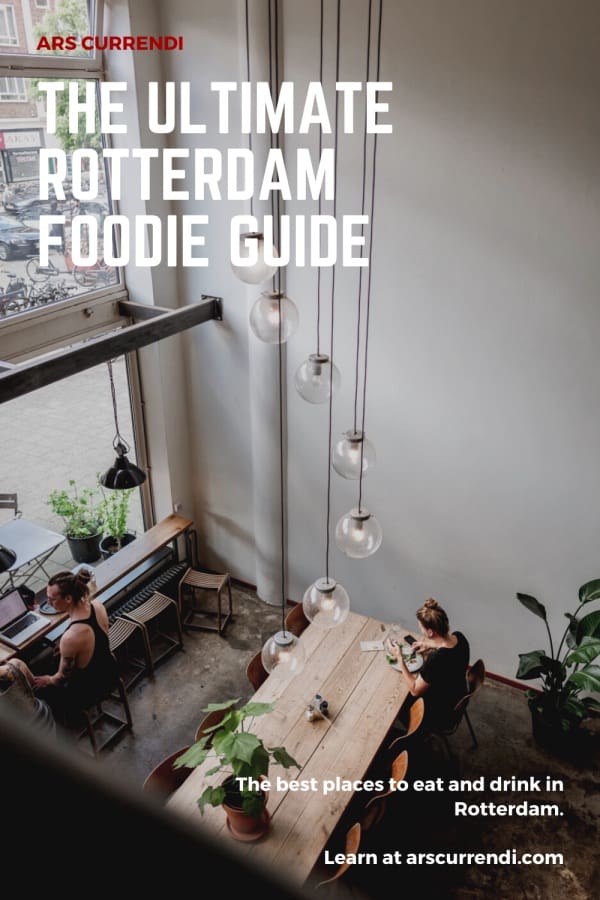
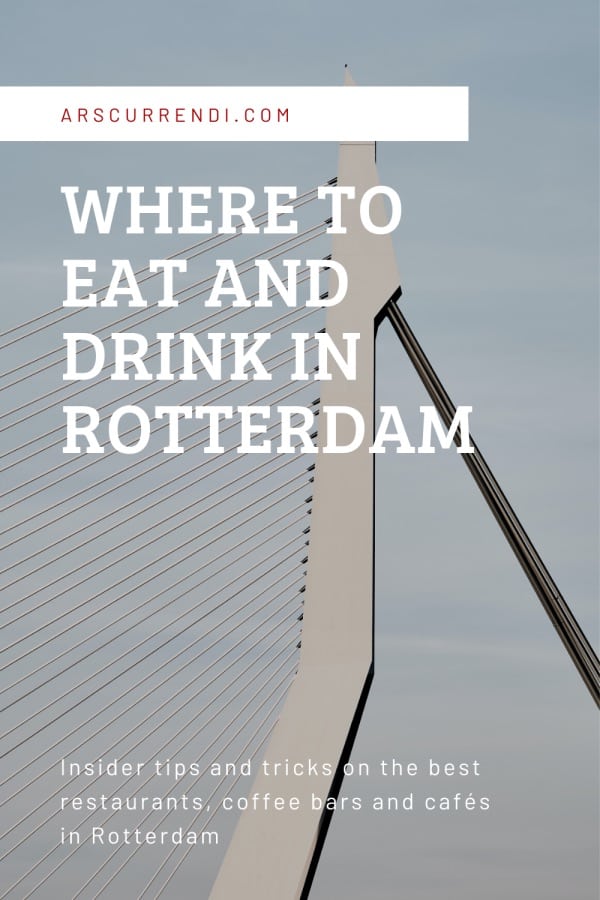
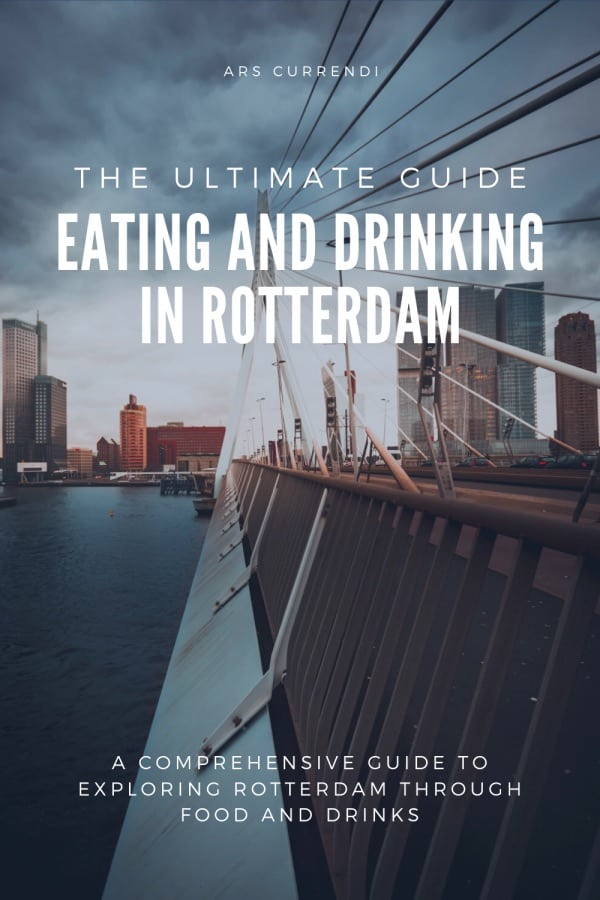
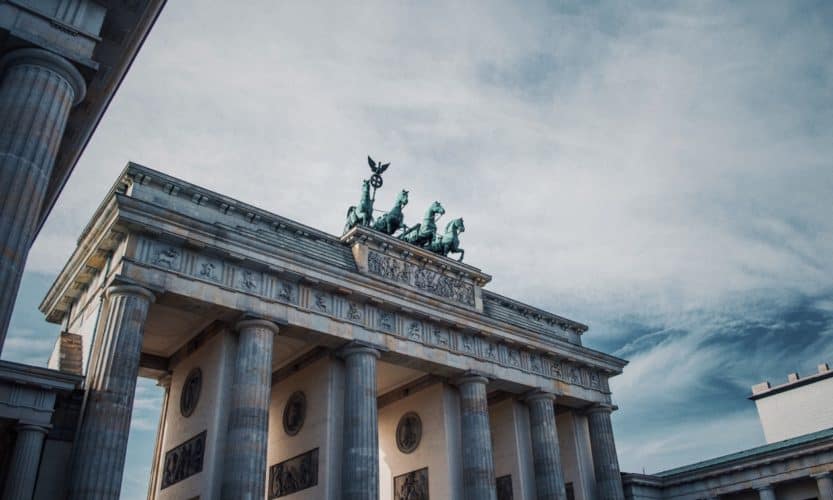
Berlin is the EU’s biggest city and the capital of Germany, and while that may lead you to believe that it will be expensive to visit, nothing is further from the truth. There are plenty of free things to do in Berlin, and I’m here to show them to you.
Before you go any further, take a look at my 3-day Berlin solo itinerary.
Now, let’s take a look at those free Berlin activities!
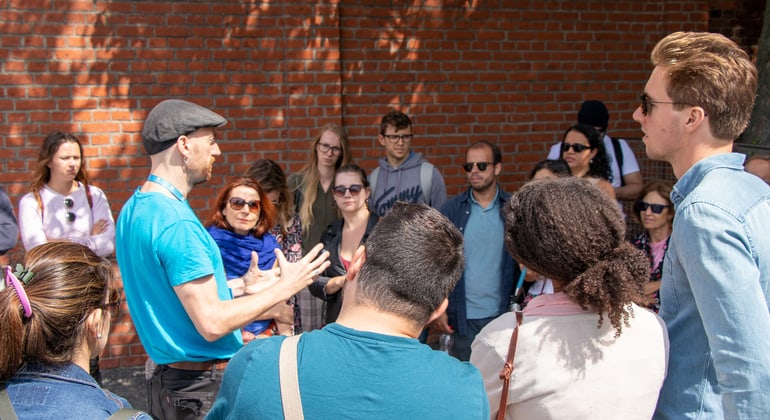
One of my favourite free things to do in Berlin — or in any city, for that matter — is to join a free walking tour.
These tours are usually guided by locals, who will show you things you’ll never find in the guidebooks.
And the best part is, there are so many different kinds of free walking tours in Berlin that you’ll be sure to find something you’re interested in.
Street art? Berlin highlights? Cold War? Whatever it is you’re looking for, chances are you’ll find it in Berlin.
Do keep in mind that free walking tours are often tip-based, meaning that they won’t be completely free.
Tempelhof was Berlin’s main airport until 2008, when it was closed and flights started operating from the city’s other airports, Tegel and Schönefeld, instead.
Today, Tempelhof Field (the runway and its surrounding area) have been converted to a public park where locals go jogging or rollerskating, or even share a picknick on a warm summer day.
More information: Tempelhofer Feld
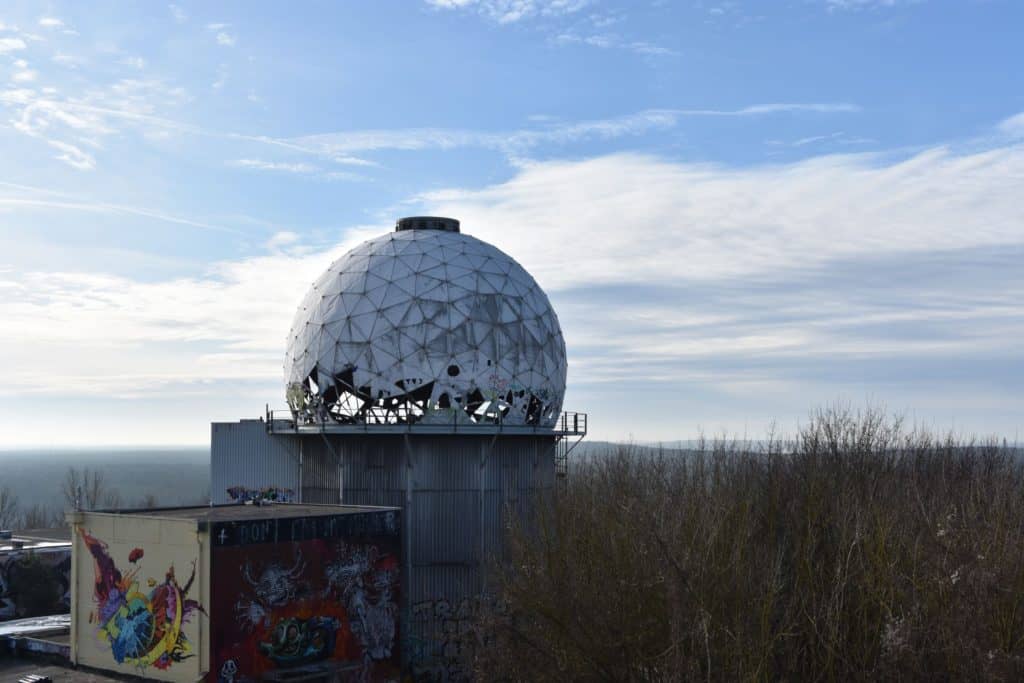
One of my favourite things to do in Berlin – as in any other city, to be honest – is to find some little-known, abandoned buildings and explore them. And, as you might have guessed, Teufelsberg is one of those.
Related: Why I visited an abandoned children’s hospital in Berlin
Teufelsberg is an abandoned spy station on a man-made hill, which has been turned into a street art sanctuary.
You’ll have to face a little bit of a hike (which took me about 30 minutes) and there’s a small fee (€5,50) to enter the grounds, but it’s more than worth it.
Insider tip: don’t bother trying to find a way to climb the towers and get to the domes. It can’t be done, unless you want to risk your life.
More information: Teufelsberg
If you’re ever looking for free things to do in a new city, a safe bet is always to find a cool neighbourhood and walk around for a few hours.
In Berlin, one of those neighbourhoods is Bergmannkiez, a small area in the southern part of the city with charming cobble-lined streets and unique shops and bars to explore.
Some possible highlights for your visit to this area are the Marheinekeplatz flea market, Another Country bookstore, PICKNWEIGHT vintage kilo store and Marheineke Markthalle.
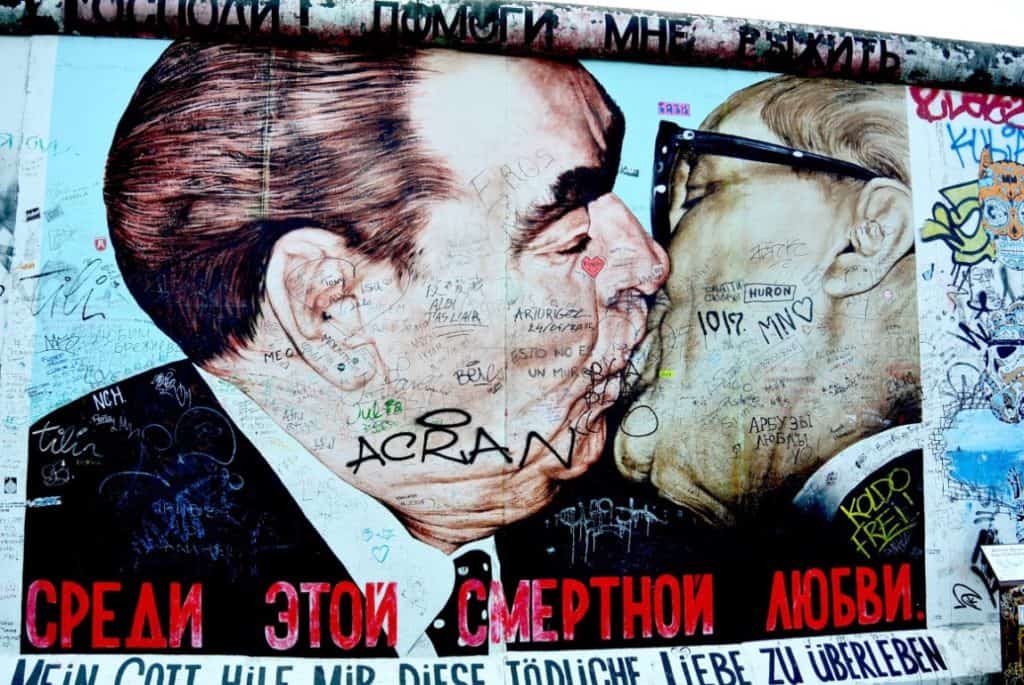
The East Side Gallery is, without a doubt, one of the most popular and best free things to do in Berlin.
As you may or may not know, the East Side Gallery consists of a series of graffiti murals painted directly on remnants of the Berlin Wall.
Fun fact: with its length of 1,4 km, the East Side Gallery is often considered to be the world’s biggest (and longest-standing) free open-air art gallery.
More information: East Side Gallery
As a city that flawlessly combines historic facades and futuristic buildings, Berlin has plenty of impressive architecture for you to discover.
So why not organise your own self-guided architecture walk?
For the specifics on what to see on your walk, I’ll let Julie from The Gap Year Edit do the talking in her article (linked below).
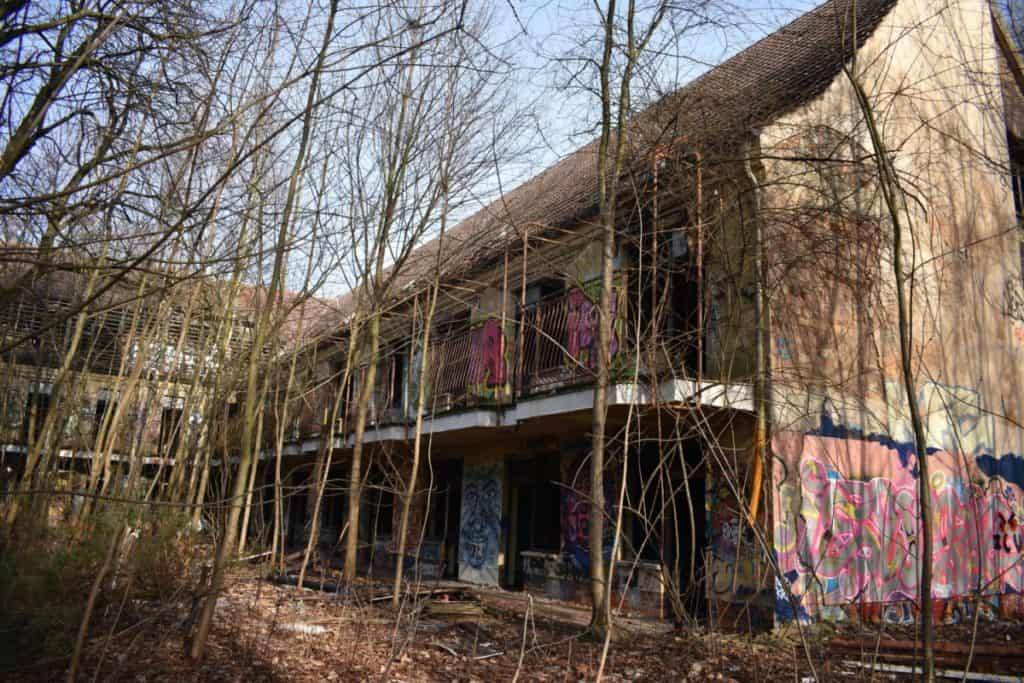
Yeah, I know. It’s a little out there. When you’re looking for free things to do in and around Berlin, your mind probably doesn’t race to an abandoned children’s hospital.
But you should at least consider it.
I did it when I was travelling solo in Berlin, and it turned out to be one of the most exciting things I did there.
(It was also one of the scariest things I’ve ever done, but let’s not talk about that right now)
Here’s some more information about how I did it, and how you can do it too:
Arts and culture are a very popular area for many cities regarding free things to do. Of course, Berlin is no different.
One of my favourite artsy spots in the city is Urban Spree, a free gallery where exhibitions, workshops, concerts and live events take place.
The exhibitions on display at Urban Spree feature contemporary art by modern artists – both German and international – and usually run for about one month.
More information: Urban Spree

The Holocaust Memorial is one of the most-visited monuments in Berlin, and for good reason.
This elegant installation serves as a humble reminder to the millions of murdered Jews and their suffering in concentration camps in and around Germany during World War II.
Additionally, an underground information centre holds the names of over 3 million Jews who lost their lives in the Holocaust.
More information: Memorial to the Murdered Jews of Europe
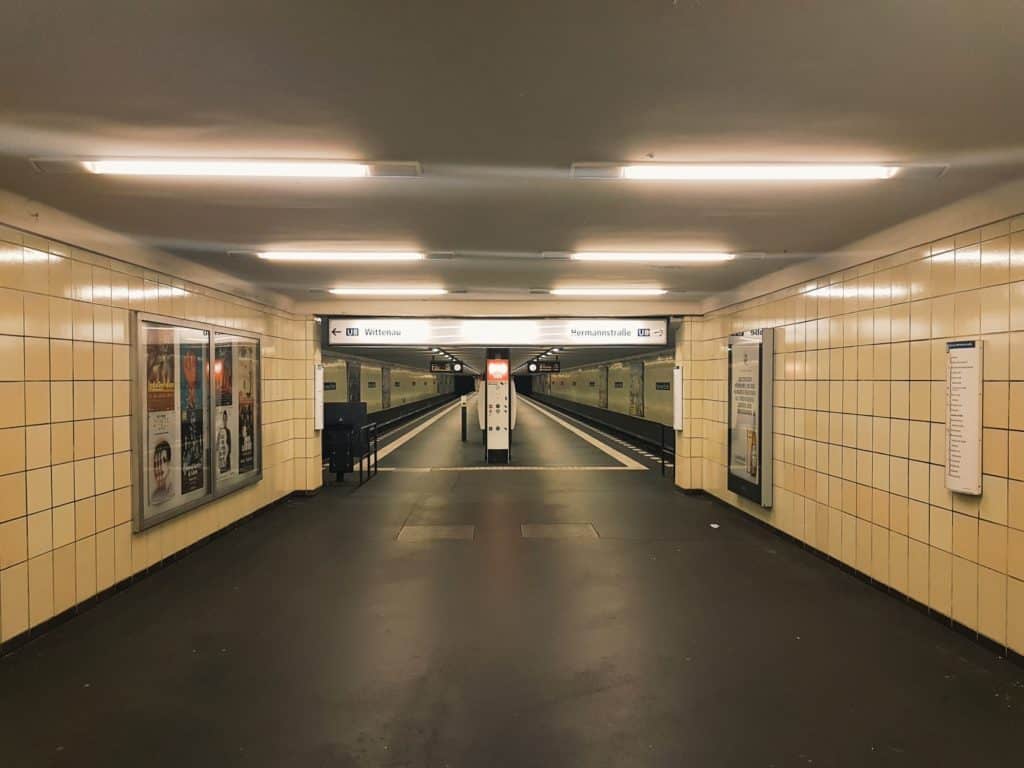
One of my favourite free things to do in any destination is just walking around without having a specific destination in mind.
Let the cobbled streets envelop you, lose yourself in tight alleys and big shopping streets. Take in the atmosphere.
It doesn’t have to be a whole day, either. Just take an hour or two and go where the wind takes you. You’d be surprised at what you’ll discover.
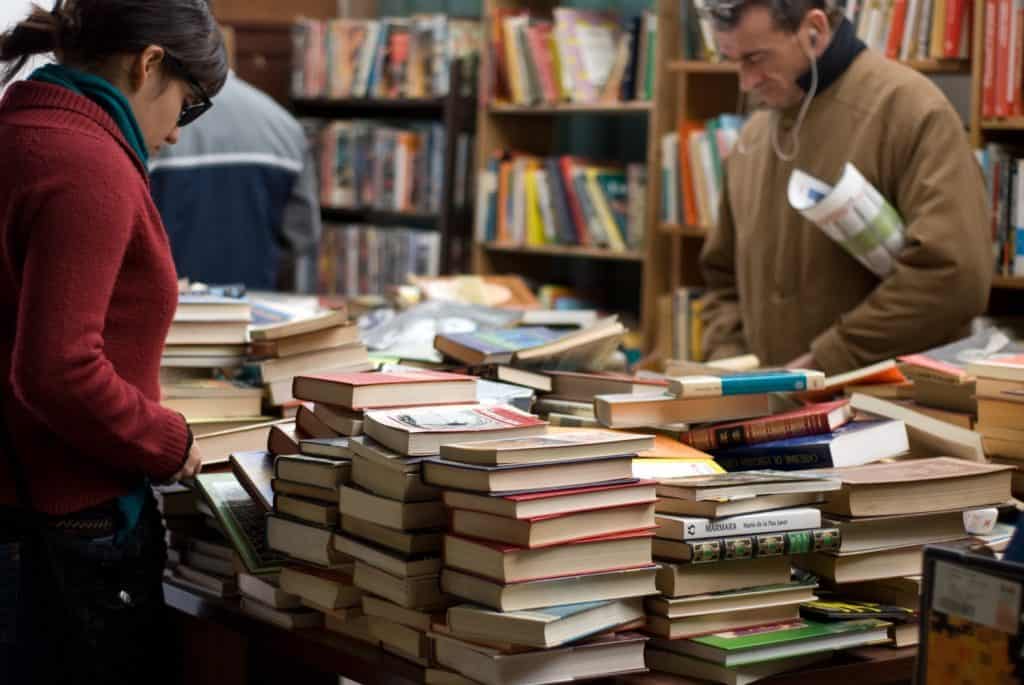
If you’re someone who gets joy out of hunting vintage posters, collecting stamps or hoarding war memorabilia, Berlin really is the place to be.
Since the city’s flea market culture is hardly a secret, you could possibly spend your entire holiday in Berlin browsing its many flea markets.
The biggest and most famous flea market in Berlin is at Mauerpark, but that’s definitely not the only one worth checking out.
Read this article about nine awesome flea markets that aren’t Mauerpark by the people from EXBERLINER.
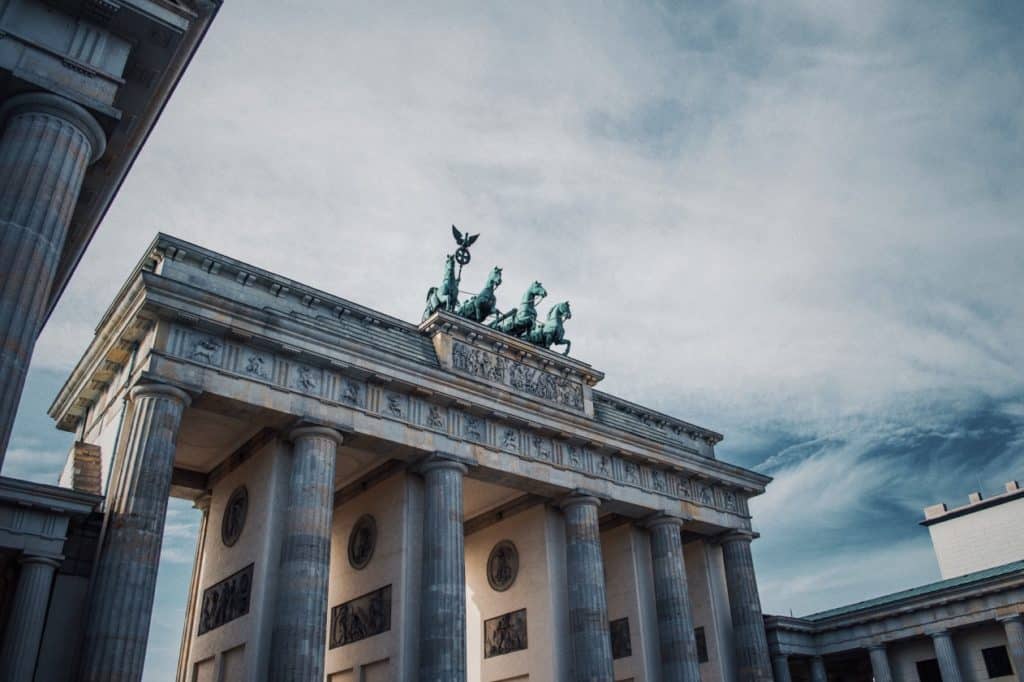
For architecture and history nerds, monuments like the Brandenburg Gate (Brandenburger Tor in German) are a sight to behold.
Constructed in 1791 on the orders of Prussian king Frederick William II, it has been the scenery for many significant events from German history.
Today, the Brandenburg Gate is considered a symbol of both the stormy history of Germany and Europe and unity and peace across the European continent.
More information: Brandenburg Gate
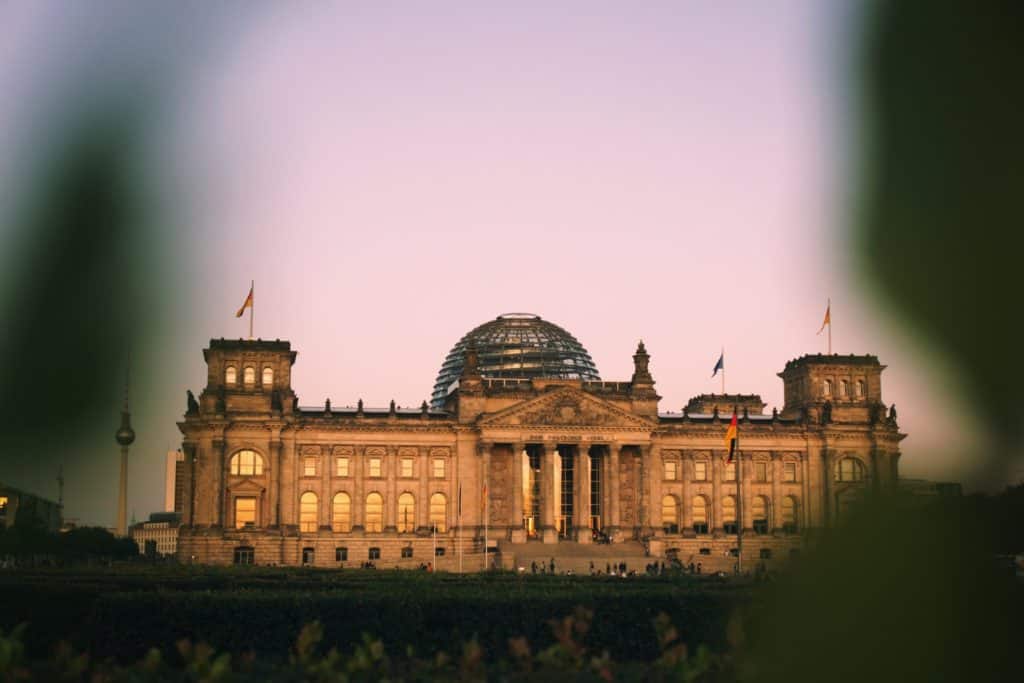
One of the city’s most historically significant buildings is the Reichstag, which has housed the German parliament since 1999.
The building stands steady in the Berlin skyline as a symbol of European and German democracy.
For visitors, one of the most interesting things to do is to climb up to the roof of the Reichstag building and enjoy the free panorama. Keep in mind that you have to register online to climb the building. (But it’s completely free!)
More information: Reichstag Building
Berlin’s Museum Island (Museumsinsel in German) is home to five museums, where you can find impressive collections besides the eye-catching exteriors of the buildings.
Unfortunately, you’ll need to purchase a ticket to actually get into the museums, but you can freely walk around Museum Island without a ticket.
One ticket costs €19 (€9,50 for reduced price tickets) and will get you into the following museums:
More information: Museum Island
Given its status as one of the most-visited war-related places in Berlin, Topography of Terror is definitely a documentation centre worth visiting.
The aptly-named Topographie des Terrors exhibition serves as a humble reminder to the terrors of the Second World War, including information about the Gestapo, the SS and the Reich Security Main Office.
Admission to the site is free and every exhibition is fully accessible for people who use wheelchairs.
More information: Topographie des Terrors
Note: the information in this post is loosely based on a Twitter thread with free things to do in Berlin that I made last year, just after I came back from my own trip to Berlin.
PIN IT!
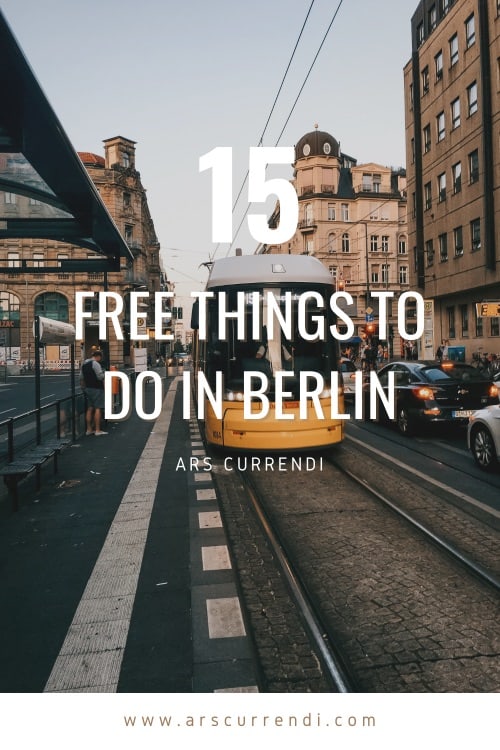
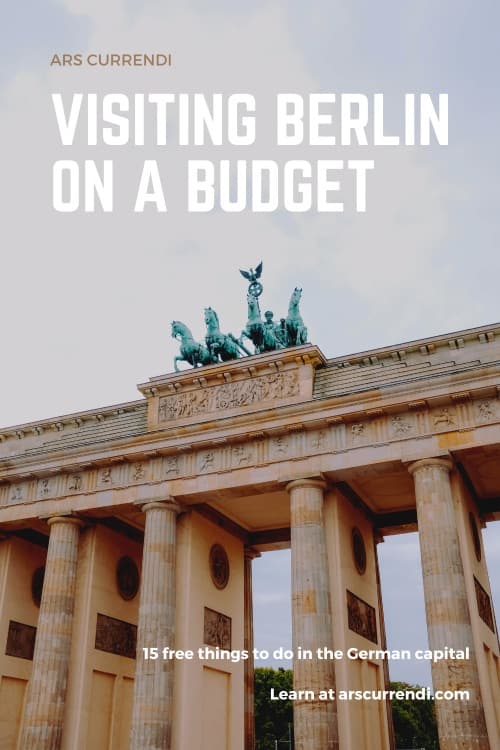
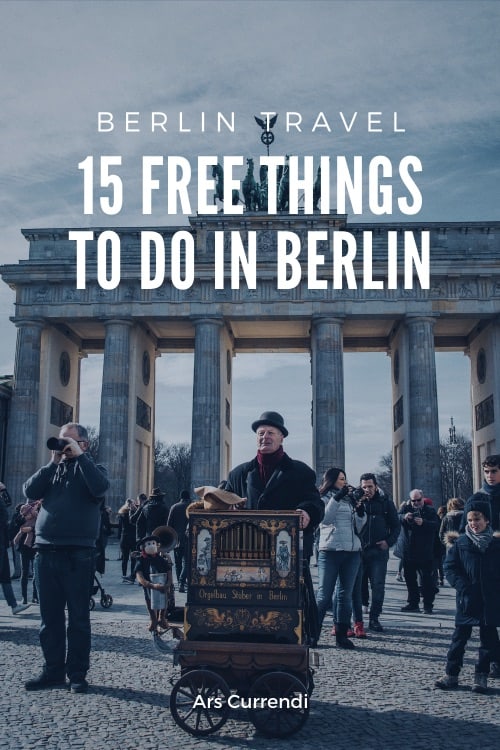
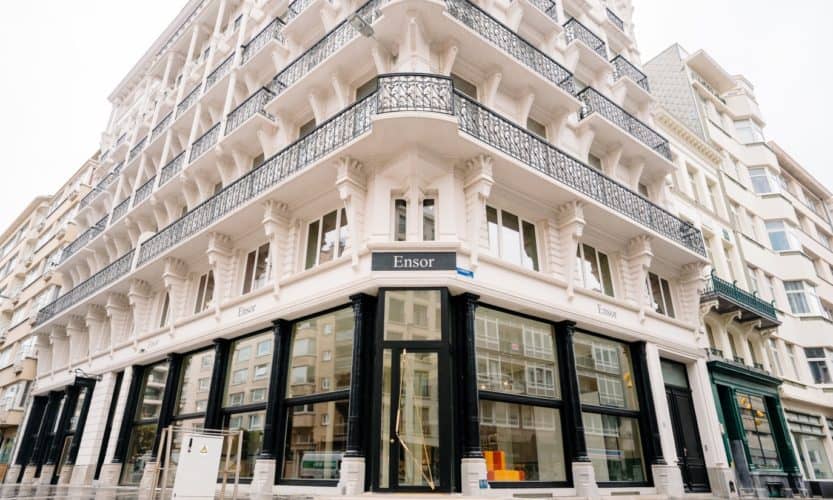
Recently, the James Ensor House in Ostend officially reopened its doors to the public in a fully renewed experience centre. This wholly refurbished experience will shed new light on James Ensor’s life, his artworks and his love for the city where he lived until he passed away: Ostend.
In the interest of discovering your own country, I decided to visit this new James Ensor House. In this post, you will read everything about my experiences; the good, the bad and the ugly.
Spoiler alert: there’s a whole lot of good and almost no bad or ugly.
Skip ahead:
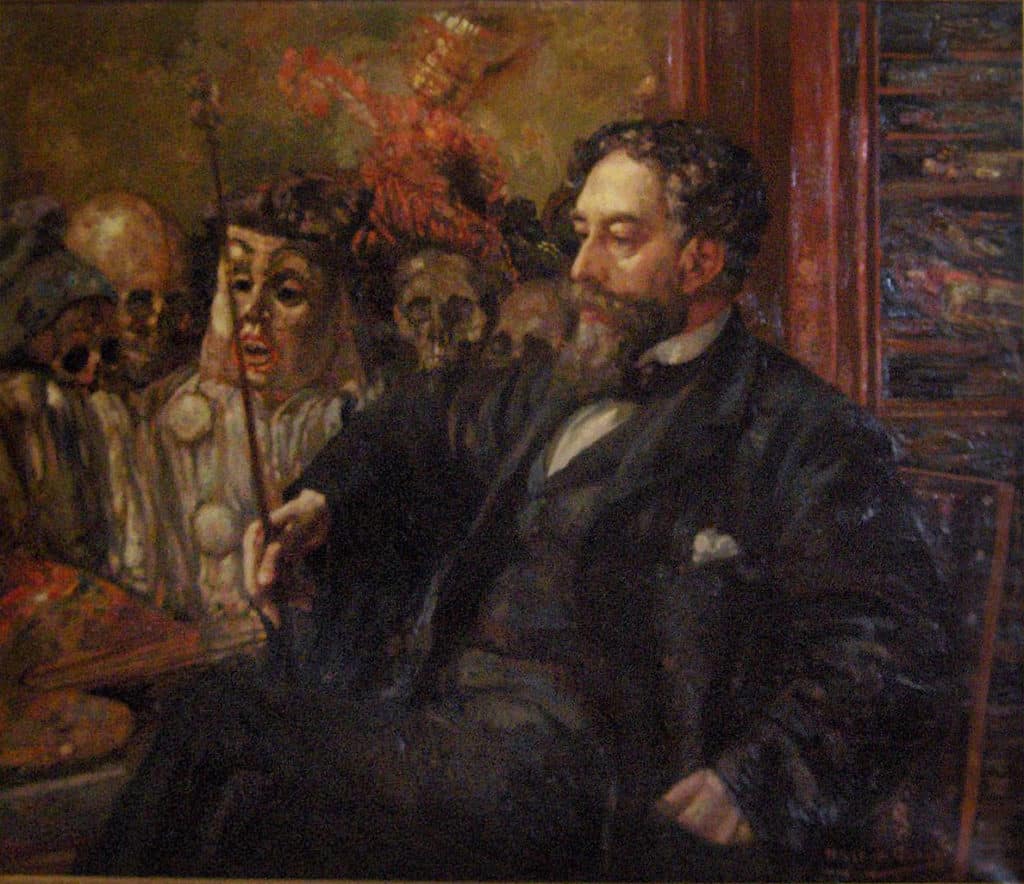
Since I know you didn’t come here for a history lesson, I’ll just give you the quick summary.
James Ensor was born in 1860 to English parents. He initially studied engineering, but quickly lost interest and left school at the age of 15 to pursue his passion for art. Eventually, he would go on to study at the Académie Royale des Beaux-Arts in Brussels, but he didn’t care for the rules and conventions of the Academy.
After leaving the Academy in 1880, Ensor started using the attic of his parents’ house as his art studio. In his artwork, nothing is off-limits – Ensor made his own rules. Critics regarded much of his work at this time as scandalous.
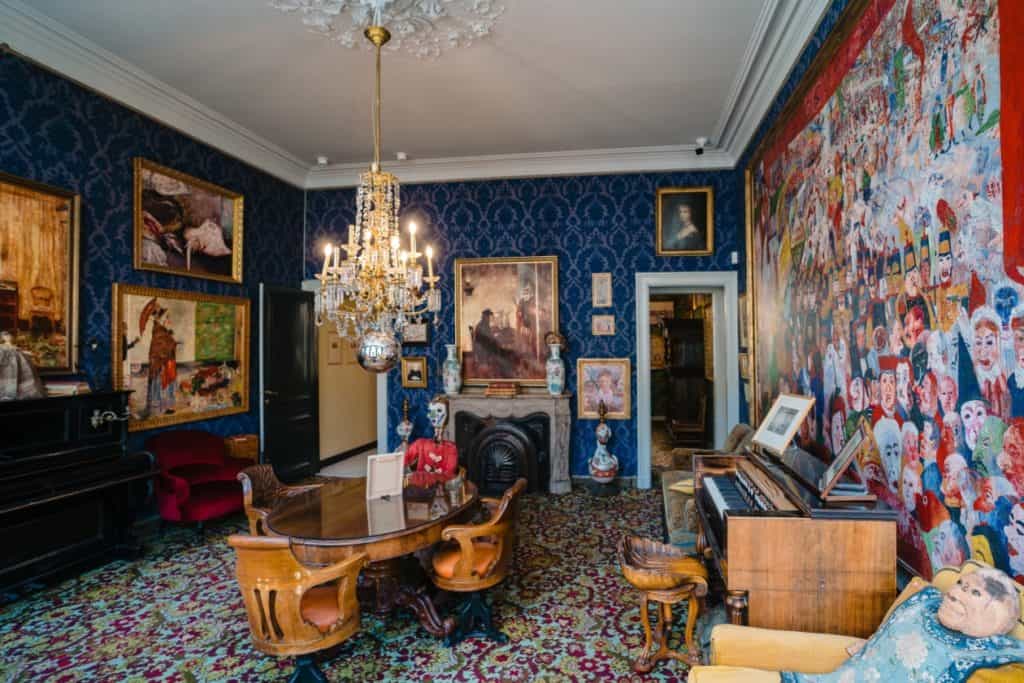
In 1888, Ensor painted his most famous work of art: Christ’s Entry into Brussels in 1889.
Ensor died, unmarried, at the age of 89 in Ostend.
Today, his works of art are on display in many leading museums around the world, including the Rijksmuseum (Amsterdam), the Musée du Louvre (Paris), the Museum of Modern Art (New York) and the J. Paul Getty Museum (Los Angeles).
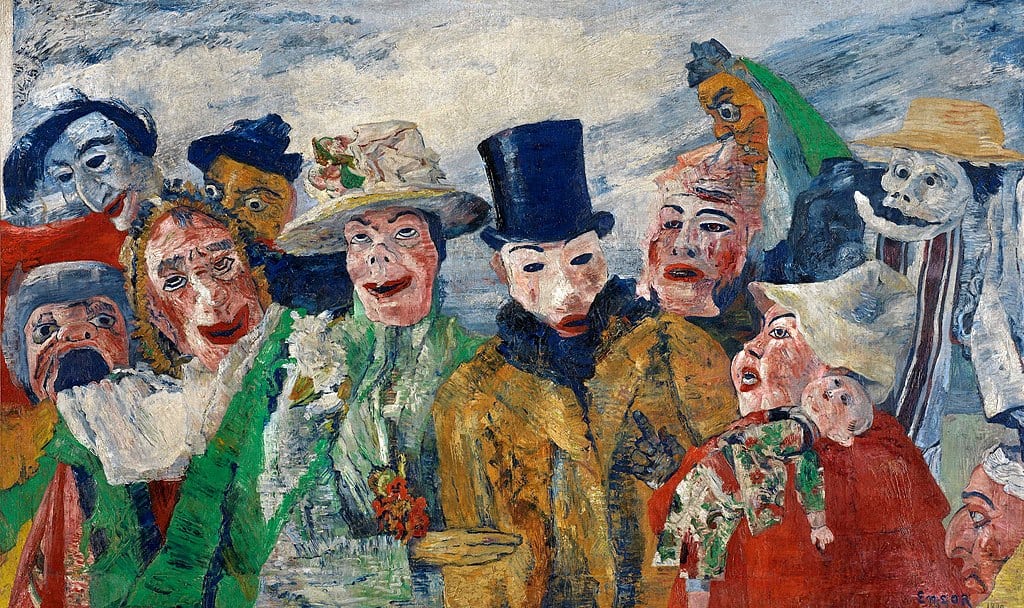
Ensor’s paintings are easy to recognise by the depiction of skeletons, carnivals, puppetry and masks (which were inspired by the masks sold in his mother’s gift shop).
These works of art can best be described as eccentric and rebellious, a perfect representation of his life in and of itself. Through his art, Ensor criticised the establishment and expressed his outrage at concepts like hypocrisy, abuse of power and injustice.
In the late 19th century, Ensor eventually came into his most creative period. Although he was an atheist, Ensor often referred to and resonated with the suffering of Christ in his paintings.
James Ensor was, and for many remains to be, one of the unsung heroes of modern art. He was one of the driving forces behind artistic styles such as expressionism and surrealism.
If you call the James Ensor House a museum, I guarantee that you’ll get a few dirty looks from the people who work there.
I’m just saying.
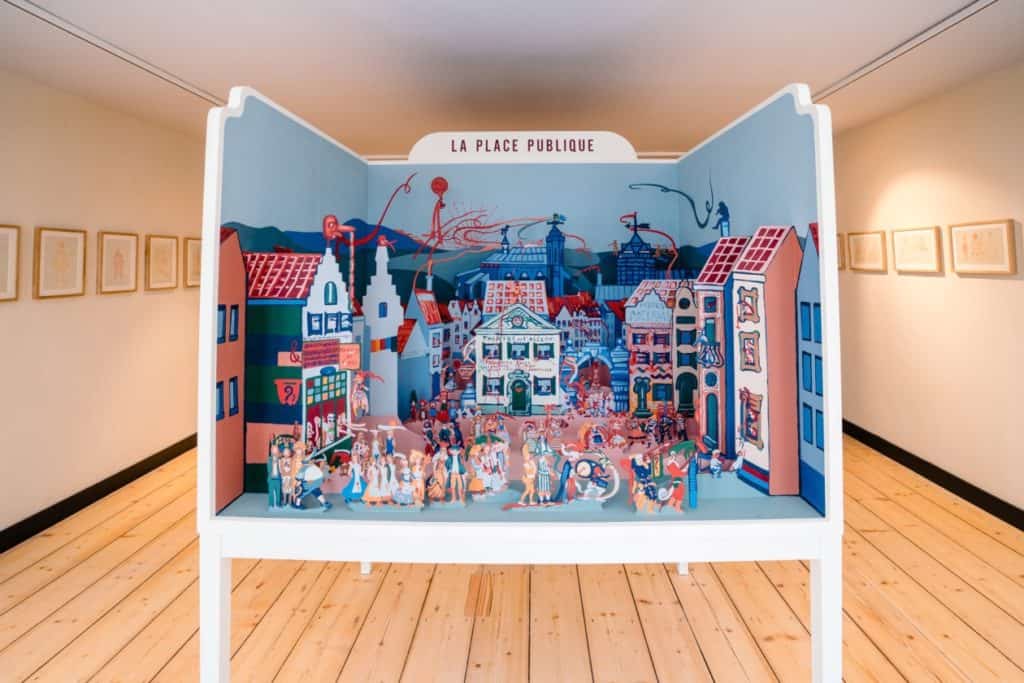
The new James Ensor House is an interactive experience centre where you can learn about Ensor’s life in a new and exciting way.
Originally, the Ensor Museum was a small museum dedicated to the artworks of James Ensor, but a recent renovation and purchase of the neighbouring building gave this place a major upgrade.
Today, a tailor-made audio guide walks you through five rooms in the James Ensor House, each one dedicated to one specific aspect of Ensor’s life and art. Also included are accurate reconstructions of the house where Ensor lived most of his life, with authentic furniture and artworks.
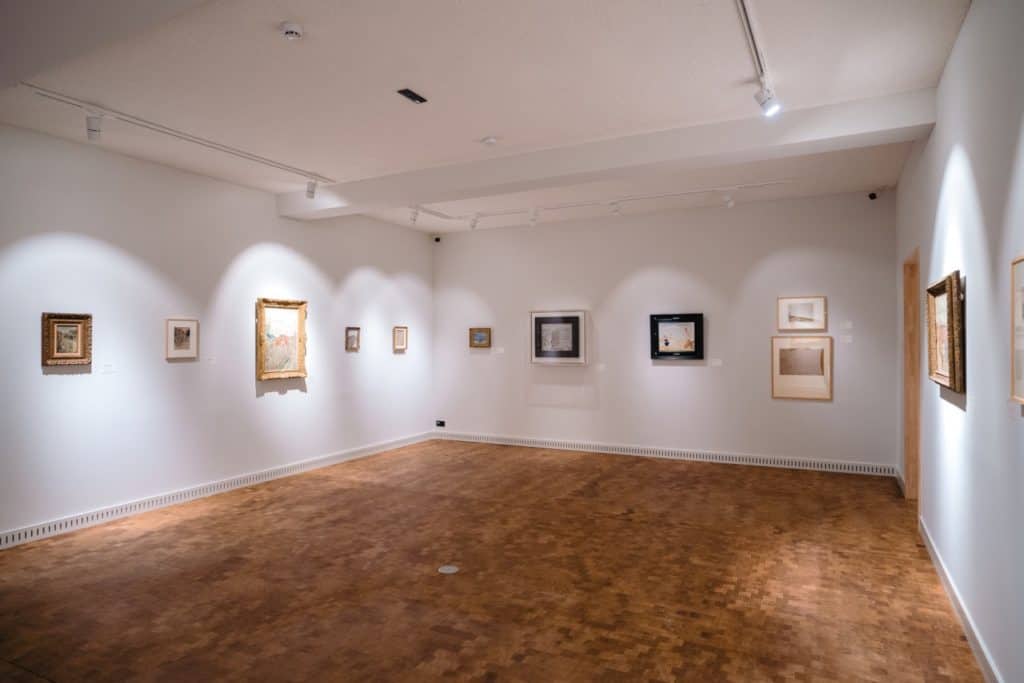
Your visit comes to an end in the museum itself, where real works of art painted or sketched by Ensor are on display.
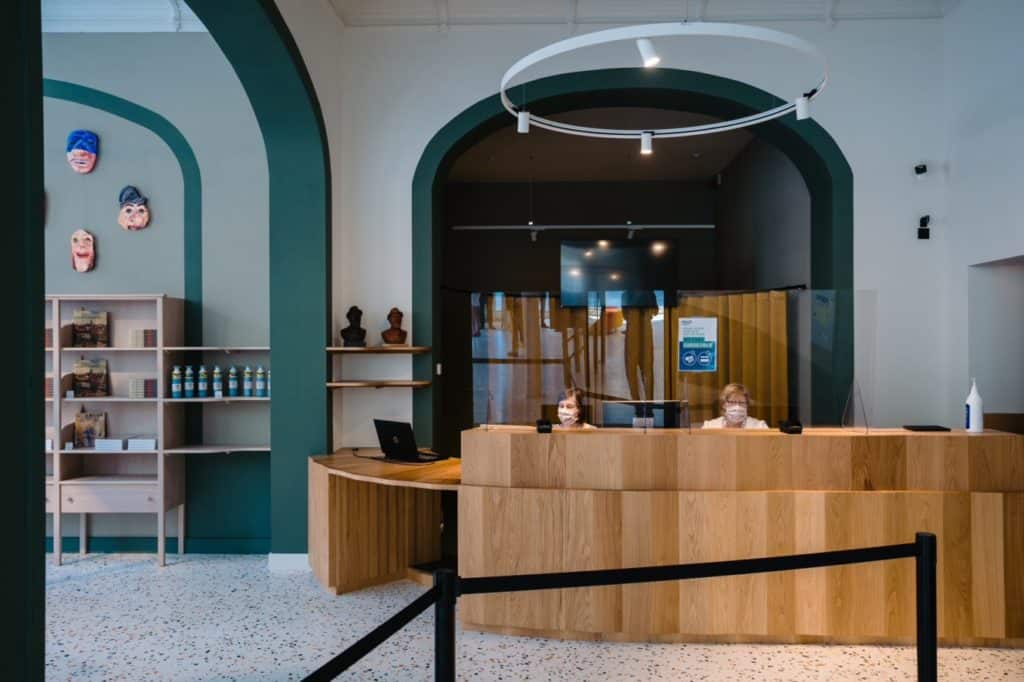
There are a few different ways to get to the James Ensor House:
If you’re not coming by train or by car, pop the following address into your favourite navigation app and follow the directions.
Vlaanderenstraat 29, 8400 Oostende
Since James Ensor spent most of his life living in Ostend, it should come as no surprise that the city decided to highlight this artist with other initiatives than the James Ensor House.
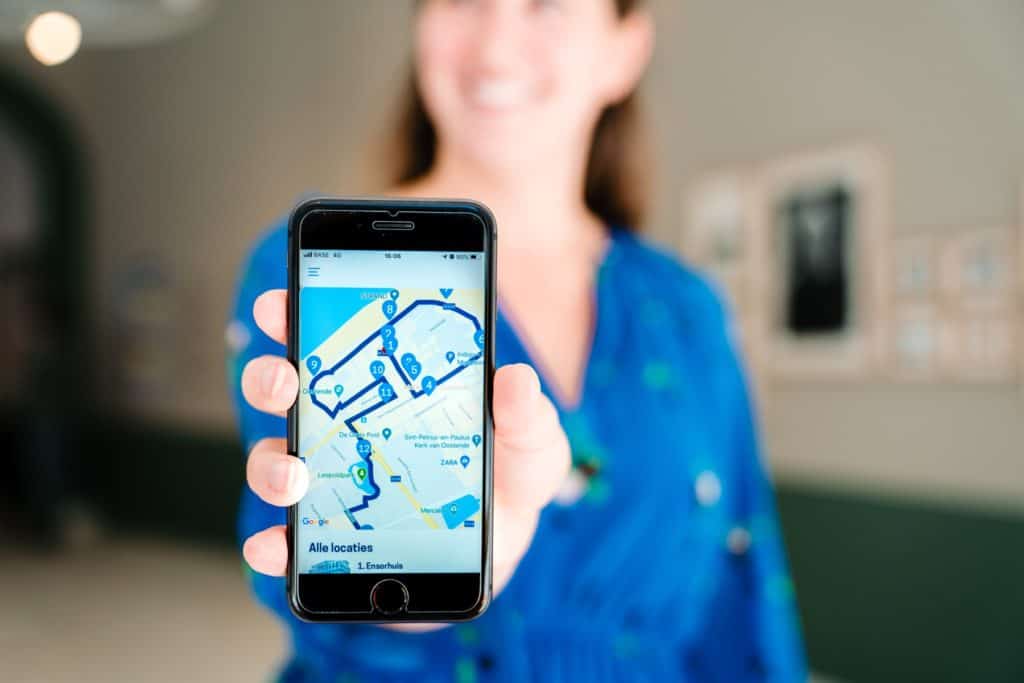
Along with the opening of the James Ensor House, Visit Oostende developed a brand new Ensor-themed walk that takes you to all the locations that played a major role in the artist’s life.
The app that accompanies this walk enables visitors to see the City by the Sea through Ensor’s eyes.
The tour is guided by Ensor himself, who talks about his own tumultuous life, his many friends and the city that stole his heart.
Best of all: the tour is free for anyone who purchased a ticket to the James Ensor House. However, if you only want to do the tour, you’ll have to pay a one-time fee of €5,49.
The app is available in five languages (English, Dutch, French, German and Spanish) and is free to download in the App Store.
Related: The 20 best apps for solo travellers
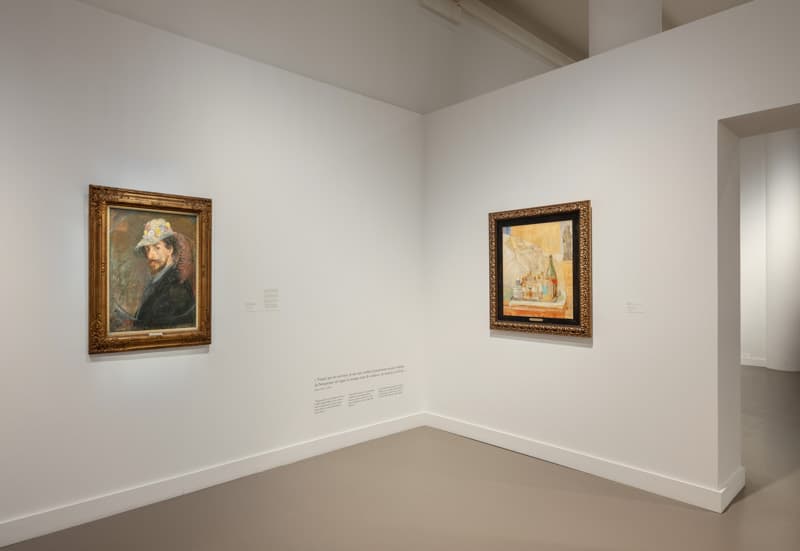
Mu.ZEE (Ostend’s museum of modern art) has an entire wing dedicated to the works of James Ensor and Léon Spilliaert, another renowned painter from Ostend.
The exhibition, which is titled Two Masters of Ostend, aims to let artworks by Ensor and Spilliaert take the visitor back in time, to the Ostend they knew and loved.
Every work of art on display in this exhibition is accompanied by one or more anecdotes, recounting the lives of people like Edgar Allen Poe and Willy Finch.
If you’re still looking for more information for your visit to the new James Ensor House, check out these websites:
PIN IT!
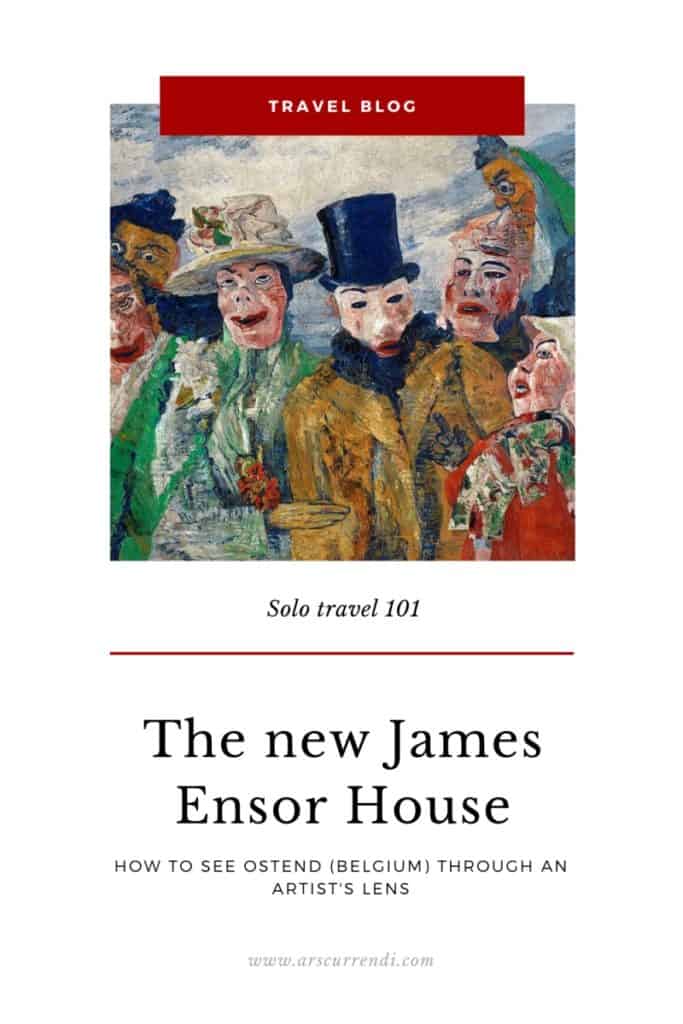
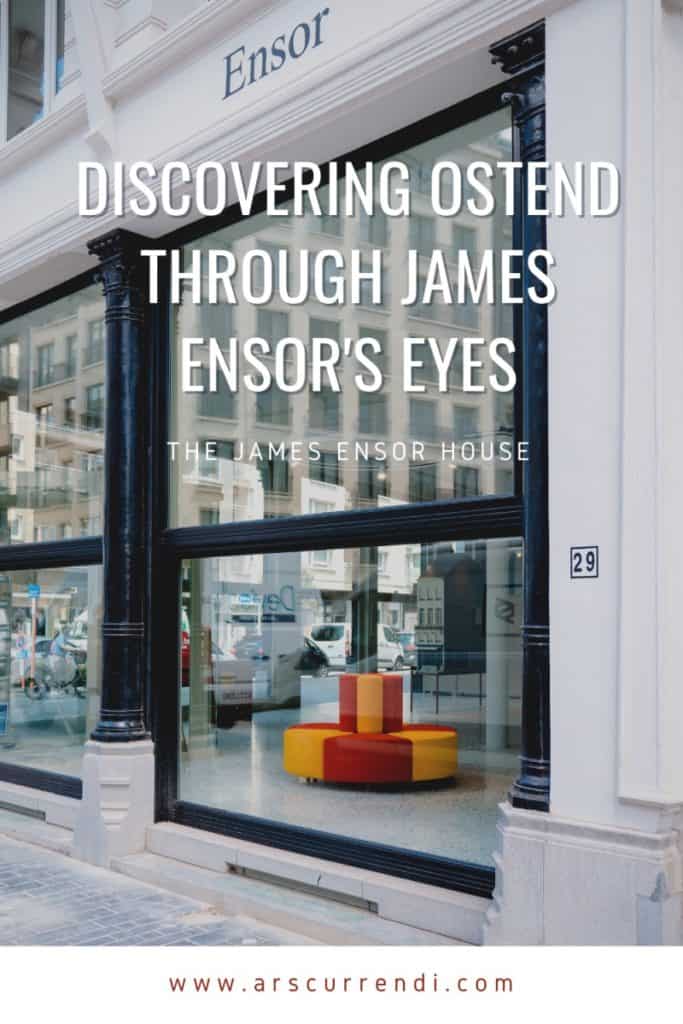
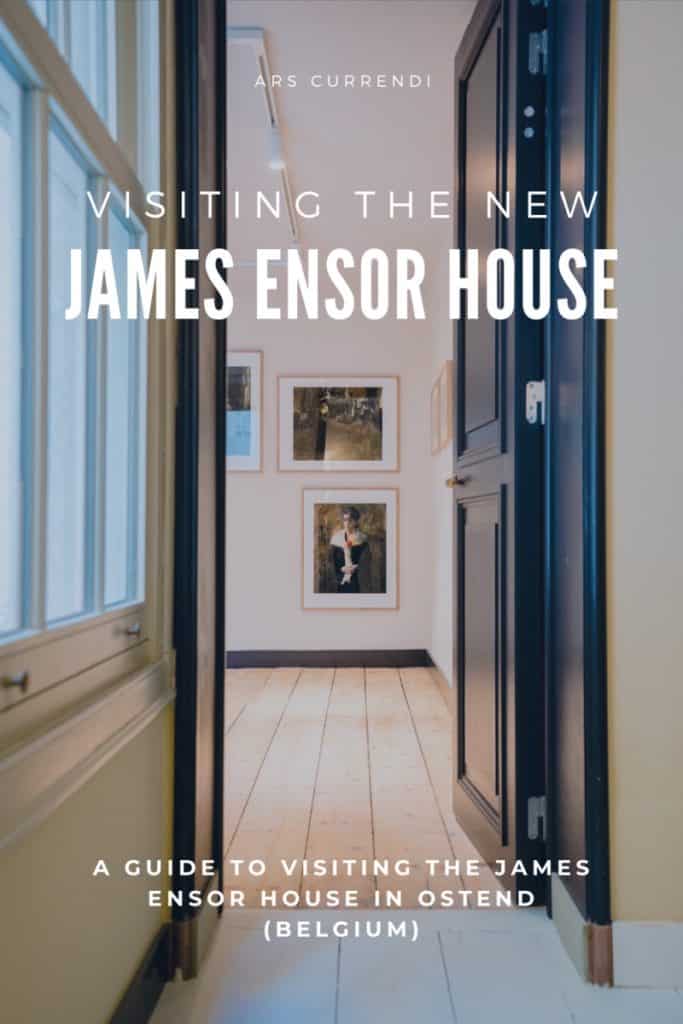
Image credits:
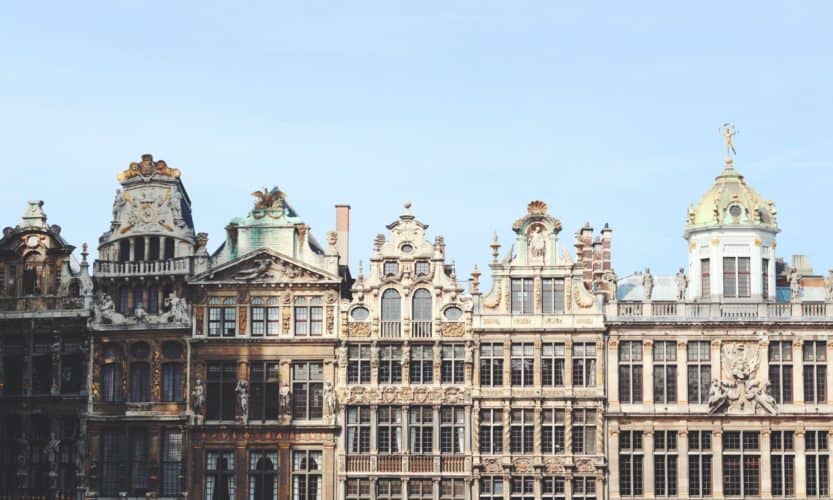
Belgium is a country that is often skipped or used as a stop between other major European cities, such as Paris and Amsterdam. I’m here to convince you that cities in Belgium are worth visiting, too.
Belgium has so much to offer, so it would be a shame to ignore its existence when building a European travel itinerary. We have it all: food that makes your mouth water, beers that have been brewed since the Middle Ages, ancient castles and cobbled streets in medieval cities.
Still wondering why this country is worth exploring? Let me go over some of my favourite cities in Belgium and convince you too.
Skip ahead with these links:
How could I start an article about the best Belgian cities and not mention the big B?
Brussels is Belgium’s capital, and if there’s one Belgian city travellers flock to by the thousands, it’s this one.
And there are some good reasons to add Brussels to your Belgian itinerary. Stunning Art Nouveau architecture, impressive museums and a groovy jazz scene are just a few of the things that might convince you.
Among locals, Ghent is mostly known as one of the major student cities in Belgium. But it’s actually much more than that.
Ghent is vibrant, quirky and welcoming to foreigners. It’s budget-friendly, eco-friendly and child-friendly. Ghent spans the bridge between historical and contemporary, and it does that better than any other city I’ve been to.
And no, I’m not overselling the city. I love Ghent with all my heart, and I would recommend it to everyone who hasn’t been to Belgium yet. (And even to people who have visited Belgium in the past!)
Read more: Ghent City Guide, As Told By A Local
As Belgium’s second-biggest city, Antwerp is still too often overlooked by travellers. And that’s a pity.
Antwerp is, beyond a shadow of a doubt, the Belgian capital of cool. The city is filled to the brim with trendy clubs, unique restaurants, authentic vinyl record shops, interesting museums, and more.
As if that wasn’t enough, strolling through Antwerp is also a treat for architecture lovers. The central station is one of the world’s most revered railway stations and the gems of Art Nouveau, Jugendstil and Neo-Classicism can be found all over the city centre.
Oh, and did I mention that Antwerp is the diamond capital of the world?
Read more: Best Restaurants in Antwerp: The Ultimate Foodie Guide
Another city that is often overlooked by people from outside of Belgium, and even by people who were born here.
Admittedly, there won’t be as many things to do in Charleroi as in other Belgian cities, such as Bruges and Ghent, but what the city lacks in activities, it more than makes up for in character and history.
If you want to venture even further off the beaten path, go for a walk along the city’s canal and discover Charleroi’s history through its (often abandoned) industrial buildings.
Although it is considered one of Belgium’s major cities, you might have never even heard of it if you’re not from around here.
So, when you’re wondering which cities to visit in Belgium, you probably weren’t considering Liège. But you should be.
Liège (or Luik in Dutch) is one of the cultural hotspots of Belgium. There’s a great opera building, a critically acclaimed philharmonic orchestra and countless events highlighting photography, poetry, music and other art forms.
This city is the place to be to discover how different cultures have influenced major Belgian cities in an authentic setting, without thousands of tourists around you.
Just because Durbuy is the smallest city in the world doesn’t mean it’s not worth a visit. On the contrary: if you explore Durbuy, you’ll find yourself wandering along an inviting labyrinth of winding cobbled streets that will transport you back in time a few hundred years.
As the city is located in the forest of Belgium’s French-speaking region, Wallonia, there are plenty of adventurous activities to try out in and around Durbuy.
Mountain biking, hiking, kayaking, caving, … If you can dream it, you can probably do it in Durbuy.
Even if you didn’t know this was a town in the Belgian Ardenne region, Spa is definitely a word you’re familiar with.
The world’s original spa resort could be found here. It was so popular that Spa became the generic term in English used to describe hydrotherapy.
But Spa is more than a glorified wellness town. Just outside the city centre, you can take a walk in nature reserves, you can go open-air karting and you can visit the oldest casino in Europe.
There’s so much to say about Leuven that I already know I’m going to struggle fitting it all in this small text, but I’ll try.
Leuven is one of Belgium’s main university cities. But it’s much more than that: Leuven has a medieval history, fascinating landmarks, a unique atmosphere and many places that are listed as UNESCO World Heritage.
Delve into the city’s student culture by having a beer at the Oude Markt, drinking coffee and eating biscuits at the university hall and visiting the historic university library and tower.
They don’t just go around calling any city the Venice of the North. It’s a nickname that has to be earned. And I’ll be damned if Bruges hasn’t earned it.
The city centre is mostly characterised by its picturesque canals and historically accurate building façades. Cobblestone bridges and streets complete the dreamy picture. The atmosphere you feel when walking around here is truly unmatched, even far beyond Belgium’s borders.
Don’t be discouraged by the small size of Bruges: most, if not all, of the people who visited the city before you will recommend it.
Looking for a specific Bruges travel guide? Check out the linked article over at Pink Luggage Abroad.
In Flanders Fields the poppies blow… And in Ypres you can learn all about that.
Ypres is arguably one of the most significant cities in Belgium in the context of the First World War, and much of the city’s tourism efforts still refer to that. For example, the Last Post is still sounded at the Menin Gate at 8 pm to remember the fallen soldiers of the British Empire and its allies.
Before you attend this daily act of homage, though, you can do several things in Ypres. Learn about the Great War at In Flanders Fields museum and the Yper museum, have a bite to eat at Les Halles, coffee at Mimi’s and take a walk along the ramparts.
Tongeren is truly one of Belgium’s best hidden gems for history buffs. As the oldest city in Belgium, founded by the Romans themselves in 15 B.C., it’s got plenty of interesting history for you to discover.
Head over to the city’s most prized museum, the Gallo-Roman museum, to learn about human life in Tongeren, from the prehistory to the Roman period.
Alternatively, head to nature reserve De Kevie just outside the city to really disconnect and take a walk without being bothered by anyone or anything.
After that, head to the Basilica of Our Lady to admire one of the largest collections of religious art in and around Belgium at Teseum.
Finish your day at one of Tongeren’s many restaurants, where you can sample local culinary delight.
Although it’s the capital city of Belgium’s southern and French-speaking region, Wallonia, Namur is yet to break through to the big audiences.
Founded as a trading settlement in Celtic times, Namur went through a period under Roman rule, until it gained recognition when the Merovingians built a citadel overlooking the city. If you didn’t know any better, you might think this was the castle on the hill Ed Sheeran was singing about.
Namur also has a number of heritage sites of military, architectural and religious significance. Some examples include the Citadel, the forts, the Belfry and the Cathedral of St.-Aubain.
Aalst is a city that’s world-famous in Belgium, but not so much outside of this small country.
Aalst is the city of onions (yes, that’s a good thing, at least if you ask the locals) and it’s also the city of the biggest — and most notorious — carnival celebration in Belgium.
When you’re here, you won’t see many other foreigners strolling through the city, unless you visit during Aalst Carnaval. Things tend to get a little crazier during this one weekend in February.
Don’t say I didn’t warn you!

At a train ride of just over one hour from Brussels and with a population of 77 thousand, Hasselt is like the younger brother of many Belgian cities.
Cultural and culinary hotspots are sprawled all along the city centre, and you can even learn about fashion and jenever (gin’s less famous predecessor) in dedicated museums.
If that’s not your thing, be sure to head to the largest authentic Japanese gardens in Europe, which are world-famous – at least in Belgium.
Kortrijk is the perfect day trip from any of the major cities in Belgium (Brussels, Antwerp, Ghent and Bruges). It only takes about an hour to get there from Brussels, and there are plenty of things to do, visit, see and eat.
One of the most impressive hidden gems in Kortrijk is Baggaertshof. Founded in 1638 by three sisters, Baggaertshof comprises an inner courtyard, twelve small houses and a gatehouse for poor widows and unmarried women. Today, this is a protected monument and it is often referred to as the ‘second beguinage of Kortrijk’.
For lunch or dinner, Kortrijk has a large variety of restaurants, bistros and eateries. Whether you’re looking for a vegetarian burger, an organic dish or just a good old steak, this city has got you covered.
Located in Belgium’s southern, French-speaking region, Dinant is a city that is packed with history due to its strategic location on the Meuse river. Even today, fortresses, old buildings and a citadel act as reminders of the city’s often bloody history.
Speaking of the Meuse river, take a walk along its banks and you’ll be reminded of the colourful houses in Danish harbours, but slightly more European. (Does that even make sense?)
And, of course, it wouldn’t be a Belgian city if there wasn’t a museum dedicated to one of our national vices: beer. Visit Maison Leffe to find out more about the story behind one of Belgium’s most famous and widespread trappist beers.
Last, but definitely not least, Dinant is the perfect base to discover Belgium’s greenest, most adventurous region: the Ardennes.
Ah, Mechelen. Granted, I may be a bit biased in suggesting this city because I study here, but still. It’s less than half an hour away from Brussels, and it’s packed with things to do.
Start by climbing St. Rumbold’s Tower‘s 538 steps to get the best 360° bird’s eye view of the city. Next, try my personal favourite beer, Gouden Carolus Tripel, at Het Anker brewery. Don’t miss a visit to the Dossin Barracks, which were used as a waiting room for death for more than 25,000 Jews and gypsies during the Second World War.
Finish your visit to Mechelen at the Vismarkt – Fish Market, in English – to blend in with the locals and find Mechelen’s trendiest places to eat, drink and dance until the early hours.
Oostende is known colloquially as the queen of the Belgian seaside cities, and that’s not an accident. It’s definitely the liveliest city along the Belgian coast, and it’s located right in the centre.
The city centre has historic roots that go back to the middle ages, but today, it is modern and eccentric. There is a huge street art walk through the whole city, and more locations are added each year. There are plenty of other themed walks, so there is definitely something for everyone.
If you’re into art, you may also want to check out the renewed James Ensor House – the house where painter James Ensor worked and lived, preserved in its original state.
When it’s time to grab a bite, try Histoires d’O‘s home made shrimp croquettes, head to Moose for a fantastic Scandinavian-themed lunch or try one of Café Botteltje‘s sixteen tap beers.
When you go to De Haan, you’re really there to relax. Since there’s not that much to do here, you might as well disconnect, put your phones away and enjoy each other’s company.
Go for a walk on the beach, rent a bike and discover your surroundings with your loved ones. Head to Aan Tafel or B.A.Z. for dinner, and count on your own B&B for a fabulous breakfast the next day.
Nieuwpoort (or New Port, as it might be translated to English) is one of my favourite coastal cities in Belgium. And, the funny thing is, I can’t really seem to explain why.
It’s just a vibe I get when I visit this city. It’s urban, but quiet. History is all around you, but the city still feels modern. I guess it’s just something you have to experience to understand what I’m talking about.
Either way, when you’re here, check out the fish auction and Jan Fabre’s giant golden turtle (yes, really!) called Searching for Utopia, and go shopping at the main shopping street.
If, after reading this, you’re still wondering which cities in Belgium are worth a visit, I don’t know what to tell you.
If, however, I have been able to spark your interest in Belgian cities, be sure to let me know! Tweet at me, leave a comment down below or send me a message.
PIN IT!



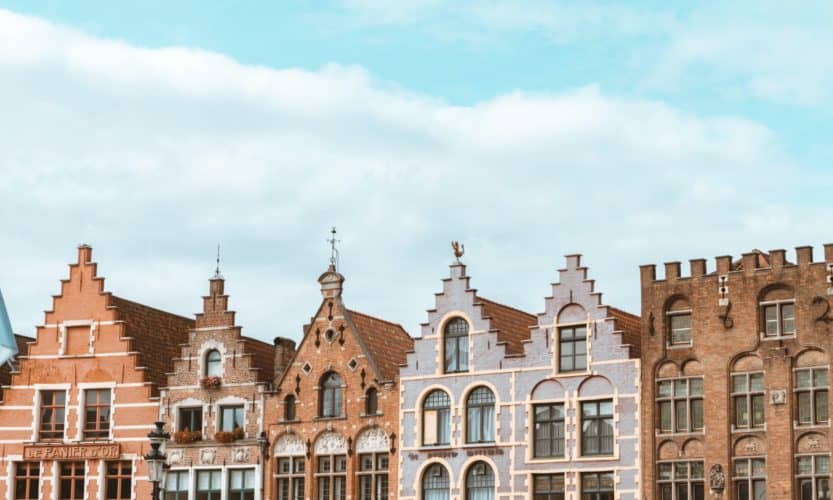
As Belgium’s third biggest city and one of its most important student hubs, Ghent is a great city to get a feel for Belgian culture without the crowds of Brussels and Bruges. And even if you’ve never heard of Ghent, no worries. This article will tell you everything you need to know. This is the ultimate Ghent city guide, as told by a local.
I lived in Ghent (or Gent, as it’s spelled in Dutch) between 2015 and 2019 as a student at Ghent University, and I still frequently visit.
This means that I can write a full Ghent city guide that shows you everything the guidebooks don’t mention and everything most tourists pass over.
There’s a good reason why The Guardian called Ghent a ‘sensory overload‘ that is just as beautiful as Bruges, without all the crowds.
Still not sure? Check out this video by Visit Gent to figure out what Ghent is all about and why so few travellers have explored it.
Without any further ado, here’s my Ghent city guide, as told by a local.
Skip ahead: Where to eat and drink in Ghent
Here are some interesting free things to do to add to your Ghent itinerary.

What is usually a quaint city square, home to the Belgian phenomenon of the Ghent Festivities, turns into a lively flea market every weekend.
On Friday, Saturday and Sunday, Bij Sint-Jacobs is the place to be for art collectors and trinket hunters. This flea market is so ingrained in the city’s cultural identity that local vintage shops and antiques galleries moved to this neighbourhood.

Ghent wouldn’t be Ghent without its historic buildings and rich culture. It’s like Bruges, but better.
Anyway, one of the things you can’t miss in Ghent is the Old St. Elizabeth Beguinage. Known as the tolerant ‘holy corner’ of the city, this beguinage houses three official places of worship: a Roman Catholic church, a Protestant church and an Orthodox church.
The open beguinage has been added to the list of UNESCO World Heritage.

These two ancient quays, that have been in use since the 11th century, have truly become the heart of the city centre — at least, for students and other locals on a warm summer afternoon.
Beautiful historic buildings are mirrored in the river Lys, which will transport you back in time about 500 years.
Don’t be shy: go to a nearby supermarket, buy some drinks and plop down here to enjoy the scenery during your picnic.
For the full tourist experience, don’t miss a boat ride on the river for another perspective on this extraordinary area.

St. Peter’s Abbey is more than just a pretty building at the main square. Behind its façade, you’ll find a pleasant garden where you’ll feel like you’re walking through a vineyard in the south of France.
Truly one of the most interesting hidden gems in Ghent, the inner garden is a reconstruction based on historical examples, meaning this is actually what the garden looked like all this time ago.
If you want a place to enjoy a picnic with your loved ones in the blissful shadow of luscious trees, look no further.
Skip ahead: Ghent nightlife guide
It’s hard to pick just a few good restaurants and bars in a city like this, but for the sake of this Ghent city guide, I had to do it.
These are some of my favourites places to eat and drink in Ghent.

An authentic beer café in one of Ghent’s most vibrant neighbourhoods that offers visitors over 300 Belgian and foreign specialty beers, both on tap and bottled. Don’t be alarmed: the inside of this bar is much larger than it appears to be from outside.
Ask any local where you should go to try our world-famous beer, and most — if not all — of them will tell you to go here.

Madam Bakster is the place to be for healthy, guilt-free coffee and cake. Every dessert you can order here is vegan-friendly, lactose-free and refined sugar-free.
Other than coming in and drinking coffee, you can also take away healthy granola, energy bars, muffins, popcorn, and more.

Admittedly, Hot Club might sound a bit too promiscuous for your cultural city trip to Ghent. I promise, it’s not what it sounds like.
Hot Club is one of Ghent’s most authentic jazz bars. It’s small, tucked away behind a cobbled alley, and a great place to have a drink and enjoy live jazz performances.
This is truly one of the city’s most gezellig locations.
(Dutch-speaking readers: let me know if you can come up with a better translation for gezellig than ‘cosy’!)

Don’t let the basic concept of healthy, gluten-free and vegan food fool you: at Le Botaniste, you’ll get affordable, colourful dishes with rich flavours to your heart’s content.
Le Botaniste is a great place to have a quick, healthy lunch in the city centre, even for non-vegan people.
As a student who spent four years in this city, I couldn’t, in good conscience, write a Ghent city guide without mentioning this restaurant.
Eggs play first fiddle in almost all dishes served at Luv L’Oeuf. This restaurant is great for breakfast, brunch or lunch dates.
You definitely get what you pay for, and you might not even be able to finish your portion.
Keep in mind that this is a cash-free restaurant, so don’t forget to bring your credit card.
Feeling adventurous? Why not head to Aywa Beirut Streetfood and share some delicious, fresh Lebanese dishes with your friends?
Its central location and affordable cuisine make Aywa the perfect restaurant for travellers looking to cut down on their food budget.
The whole vibe inside the restaurant is very Mediterranean and the staff is really helpful, especially when you don’t really know what you’re getting into.
Skip ahead: Most Insta-worthy locations in Ghent
While Ghent may seem like the small brother of nearby major cities like Antwerp and Brussels, its nightlife is in no way inferior, thanks to its vibrant student population.
And, hey, what’s a Ghent city guide without talking about nightlife?

Most major clubs in Ghent are concentrated in or around this street. If you want to dance the night away to funky beats or sing along to the newest pop jams until dawn, Overpoort is your best bet.
Keep in mind that, since this street has so many clubs, it can get crowded with partying students, especially on Thursday night.
Don’t forget to grab a post-dance snack at one of the many well-established restaurants around. I highly recommend going to Stefano’s Place and ordering a julientje. It might not look appealing at all, but it tastes amazing after — or during — a night out.

For students, the main alternative to the always busy Overpoort is Vlasmarkt. This square is home to many alternative dance pubs and cafés.
The most esteemed café here is Charlatan, a popular venue that often hosts live events. The three different rooms become the decor for standup comedy, live gigs and DJ sessions on a nearly nightly basis.
The Ghent Festivities (Gentse Feesten in Dutch) are a ten-day cultural summer festival throughout Ghent’s city centre. The festival includes free music on 10 squares, street performers, indoor and outdoor activities, and late-night parties.
Thanks to its tradition of over 170 years, the Ghent Festivities have become something to look forward to for people from Ghent (and, admittedly, from all over Belgium).
There is also a one-month winter version of the festival in December, which includes a Christmas market, an ice rink, a ferris wheel and many bars and food trucks.

To be completely honest, Polé Polé is a part of the Ghent Festivities I just described. However, I believe it’s worth a separate entry.
It’s like a party within a party. And, believe me, these people know how to throw a party.
Polé Polé brings the hottest latin and afro beats to the historic city centre of Ghent, with a dance floor suspended over the river Lys.
Skip ahead: Where to shop in Ghent
Nowadays, it’s safe to say that a whole lot of people enjoy sharing their holiday snapshots on social media. And hey, I’m not here to judge. In fact, I’m here to help you find the best Insta-worthy places in Ghent.
I did a similar thing a few months ago: Instagrammable locations in Lyon, France
Just so you know: the ‘How to get there’ part for these locations mainly uses public transport (trams and buses) and starts at Ghent’s main railway station: Gent-Sint-Pieters.
If you thought Bruges took you back to the Middle Ages, wait until you step foot in Patershol.
With spectacular views all around you, this bridge is the perfect spot for a romantic selfie with your significant other.
While graffiti is officially prohibited in Ghent, the authorities turn a blind eye for artists in this particular street. As the canvas changes every day, you’re sure to find some great Insta-worthy shots here.

If you were still looking for a backdrop for your #summerloving shots, look no further. Graslei & Korenlei have attracted locals and travellers alike for years.
This district, that mainly functions as students’ residential quarters by day, transforms to an idyllic site by night.
Skip ahead: Ghent city guide PDF
Let me preface this part by saying this: I’m not a big shopper.
That being said, I compiled this list of stores in Ghent based on recommendations from friends and some stores that I personally enjoy shopping at. (Yes, even with my limited experience!)
Start by watching this short video by Visit Gent about the shopping experience in Ghent.

Think Twice is a vintage / second-hand store with two locations in Ghent. It’s one of the leading sustainable fashion brands in Belgium.
Fun fact: the entire collection at Think Twice is renewed every 5 weeks and the organisation behind this brand also gives back to the community.
Originally founded in 2010 by a small group of creatives, & Other Stories quickly grew out to be the recognisable clothing and beauty brand it is today.
The collections are designed in local ateliers in Paris, Stockholm and Los Angeles.
Whether you’re looking for a statement piece for your coffee table or a funny booklet for the bathroom, The Other Shop is where you’ll find it.
The Other Shop is a charming book and gift shop in Ghent’s city centre, specialising in cookbooks, photo books and other interior accessories.

Want to pimp your interior design or give somebody a thoughtful present? PIET Moodshop has got you covered.
Fun fact: the people behind this gift store also provide useful design advice by phone or email.
MOVIES is a clothing store for men and women in Ghent’s vibrant student district. Whatever piece of clothing you’re looking for, chances are you’ll find it here.
I promised you a downloadable PDF of my Ghent city guide, and I wasn’t lying.
Enter your details below to subscribe to my mailing list and get instant access to your Ghent city guide. (Well, nearly instant.)
PIN IT!
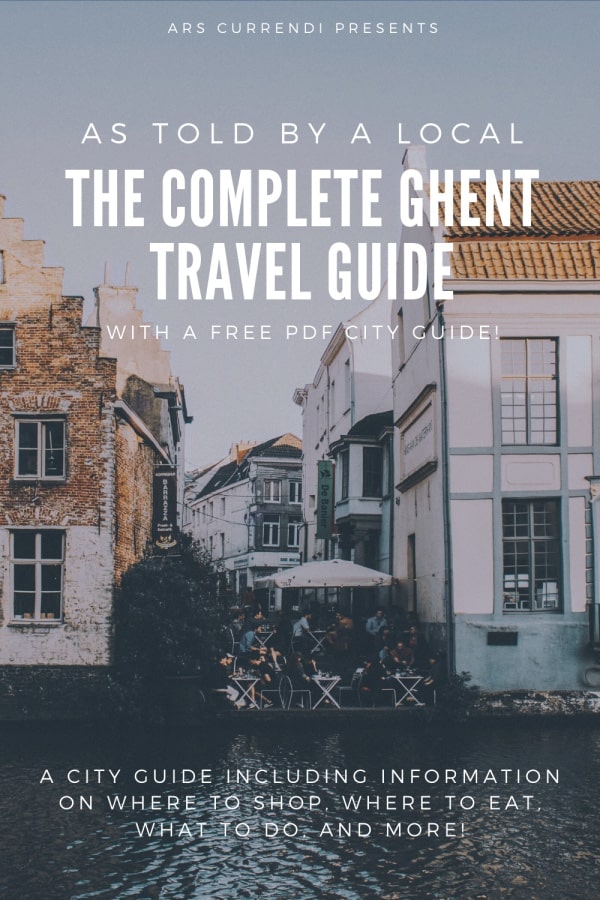
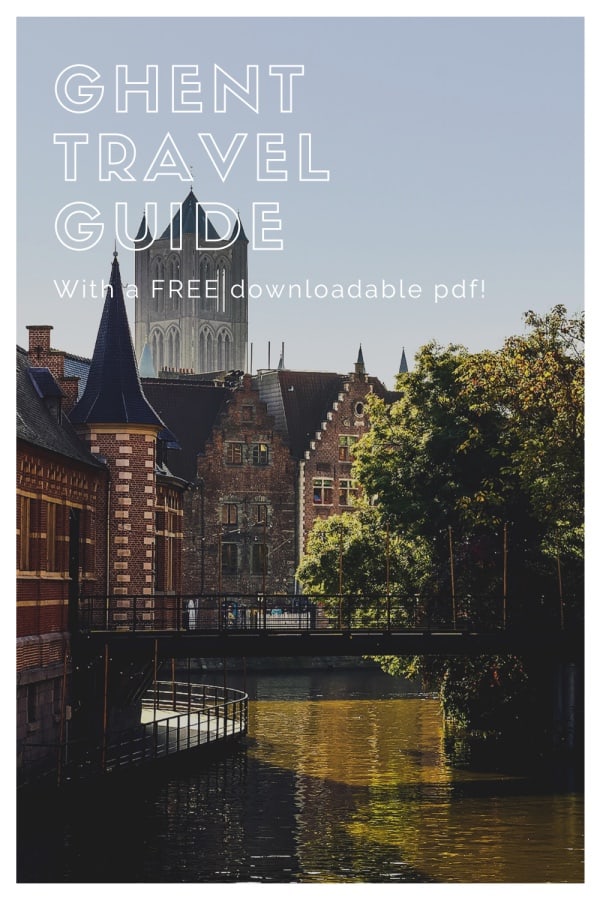
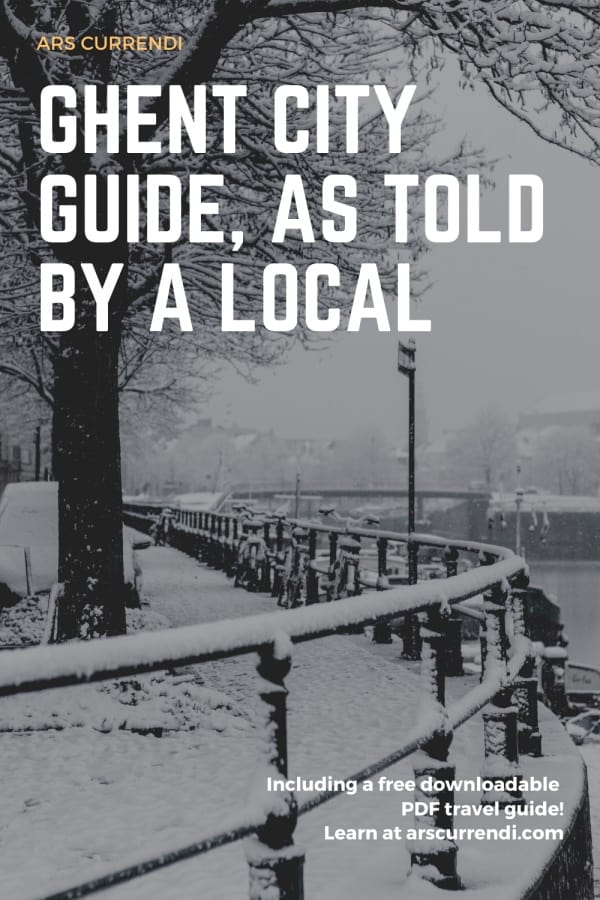
Design by NXNW.